Unraveling the Threads: An Exploration of Clothing in the Ancient World
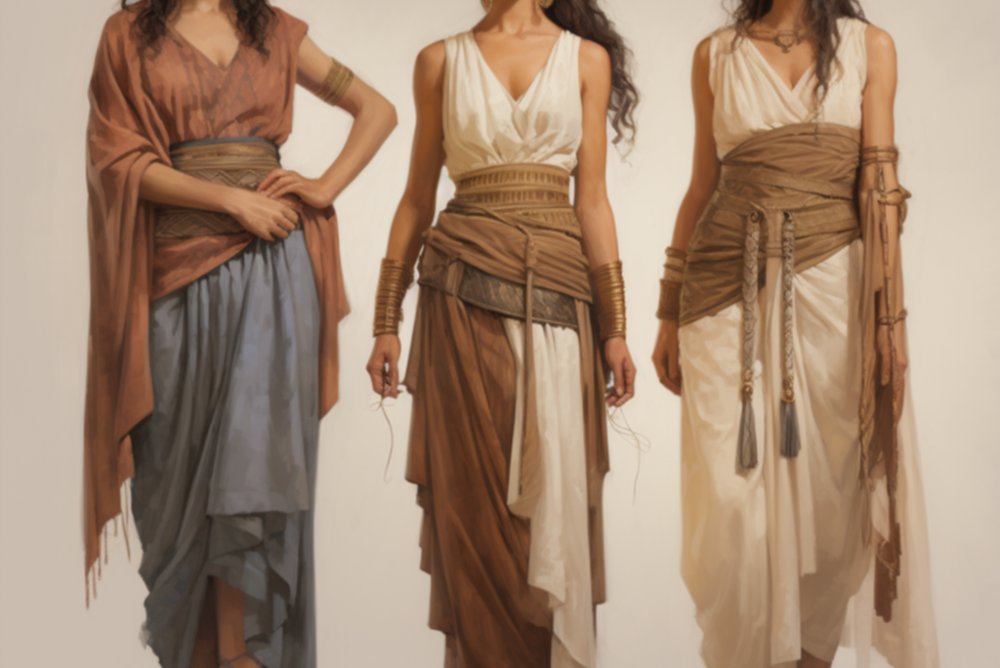
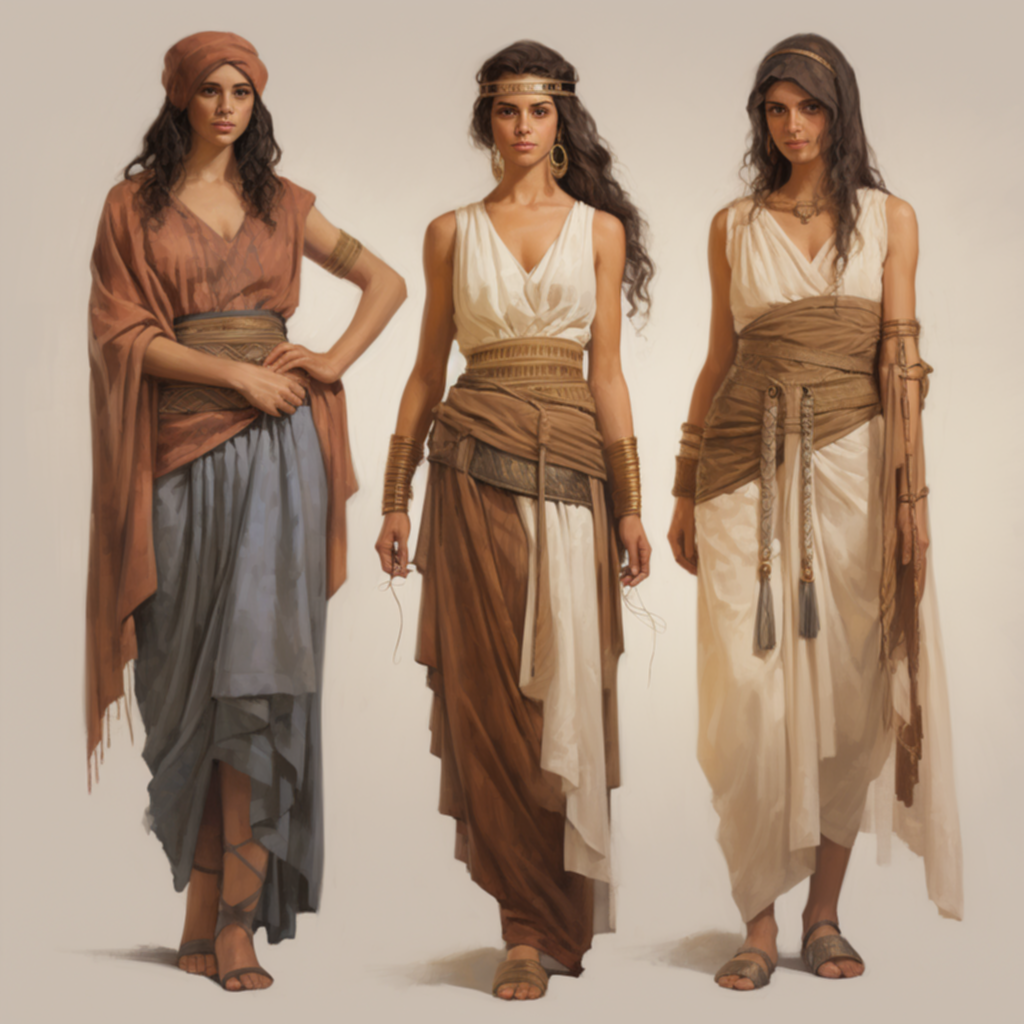
Delving into the threads of history, one is met with a myriad of tales spun from the fabric of the past. Central to these narratives are the intricate tapestries of clothing and costumes worn in the ancient world. Tracing back the patterns, styles, and materials used in antiquity provides a fascinating glimpse into the cultures that created them.
This comprehensive exploration on "Clothing in the Ancient World" aims to weave a narrative of how ancient civilizations clothed themselves. This journey traverses the sands of Egypt, the city-states of Greece, the vast expanse of the Roman Empire, the dynasties of China, and the vibrant cultures of India. As we stitch together these narratives, we will unravel the profound influence of climate and geography, uncovering the complex interplay between environment and attire.
In doing so, we hope to not just understand the clothing of yore, but the ethos, beliefs, and social structures that these vestments encapsulated. So, let us embark on this sartorial journey through time, navigating the ancient world through the lens of its apparel. From tunics to togas, loin clothes to elaborate gowns, this exploration is designed to unfold the fascinating saga of clothing in the ancient world.
The Function of Clothing in the Ancient World
Clothing in ancient times, much like today, served an array of purposes beyond mere protection from the elements. Each garment bore testimony to the social, cultural, and economic dynamics of the civilizations that created them. In this chapter, we seek to explore these complex layers of significance.
1.1 Social Status and Hierarchy
Clothing in the ancient world was a crucial indicator of an individual's social standing. Variations in design, material, and embellishment were reflective of a person's rank within society's hierarchical structures. Royalty, for instance, was often distinguished by elaborate garments made of fine materials and adorned with intricate details, while commoners typically wore simpler, more practical attire.
1.2 Religious Significance
Religion significantly influenced clothing choices in the ancient world. Certain garments and accessories held sacred significance and were reserved for religious ceremonies. Some were worn by clergy, while others were donned during religious rituals or festivals by the general populace.
1.3 Cultural Identity
Clothing also served as a strong symbol of cultural identity. The unique characteristics of attire across different ancient civilizations – such as the draped silhouettes of Greek chitons or the elegant drapes of Indian sarees – represented their distinct aesthetic sensibilities and cultural ethos.
1.4 Practicality and Comfort
The practical aspects of clothing – comfort, ease of movement, and suitability for local climate – were pivotal considerations in their design. Materials, garment construction, and clothing styles were often adapted to suit the climatic conditions and lifestyle requirements of each civilization.
1.5 Aesthetics and Beauty
Finally, ancient clothing was not devoid of aesthetic considerations. Artistic elements – including color, pattern, texture, and embellishment – played a significant role in enhancing the beauty of garments, reflecting the artistic sensibilities and craftsmanship of these civilizations.
To delve deeper into these facets, let's journey through various ancient civilizations and explore the specifics of their sartorial traditions.
Now, with this understanding of the multifaceted roles of clothing, let's begin our in-depth exploration of each civilization's unique sartorial traditions, starting with ancient Egypt.
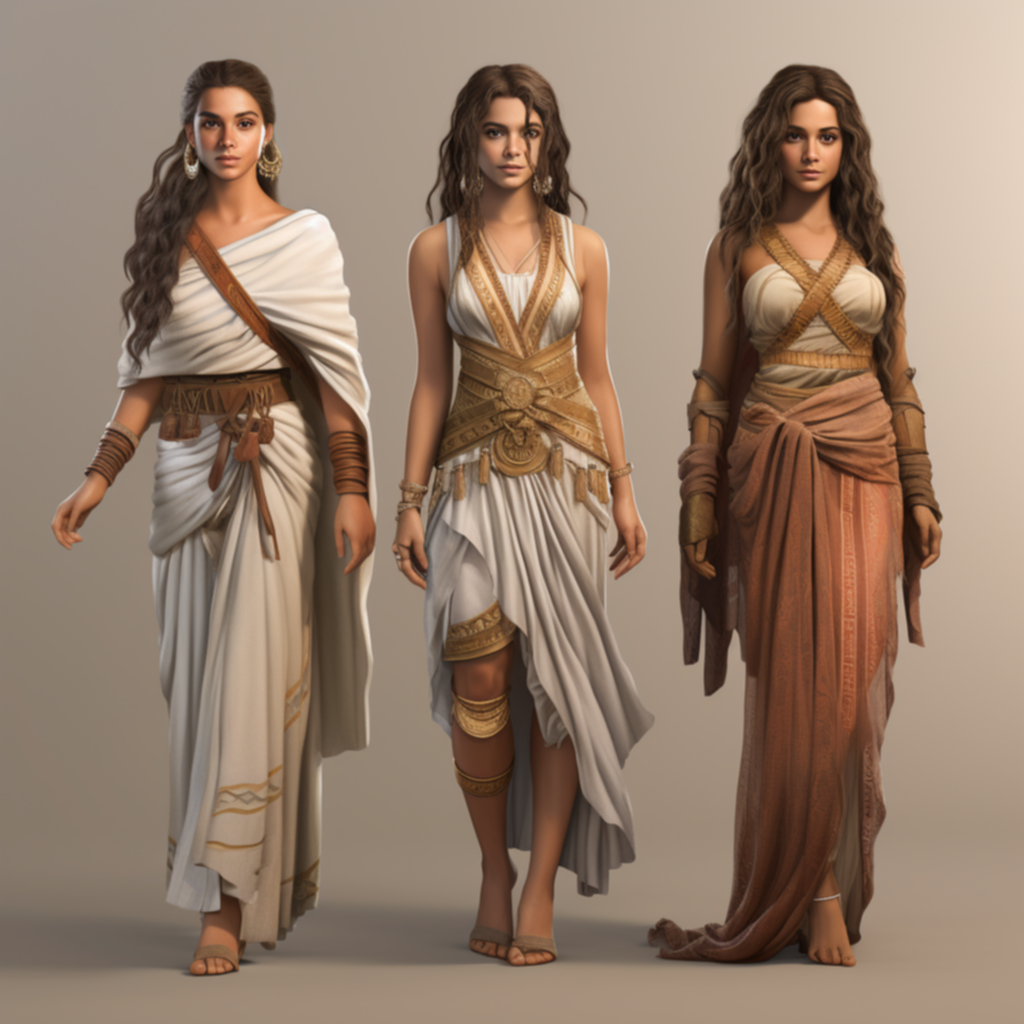
Ancient Egyptian Clothing
Located in the northeastern corner of Africa, the civilization of ancient Egypt was renowned for its monumental architecture, mysterious hieroglyphics, and sophisticated system of governance. The clothing of ancient Egyptians was as distinctive as their culture, reflecting their social hierarchies, religious beliefs, and practical necessities in a desert climate.
2.1 Material and Production
The ancient Egyptians primarily used linen to make their clothing. This was due to the abundant availability of flax, the plant from which linen is derived. Egyptian linen was known for its high quality, with some fabric woven so fine it resembled silk.
2.2 Clothing for Men
Men's attire in ancient Egypt was generally simpler than that of women. Most men wore a short skirt known as a shendyt, which was knotted or belted at the waist. The length and breadth of the shendyt varied according to the wearer's status. Laborers and servants usually wore short versions for ease of movement, while Pharaohs and high-ranking officials donned longer, wider shendyts.
2.3 Clothing for Women
Ancient Egyptian women wore full-length dresses called Kalasiris. These were often form-fitting and held up by straps around the shoulders. More elaborate versions, worn by noblewomen or queens, were adorned with pleats or fringed edges.
2.4 Children's Clothing
Children in ancient Egypt usually did not wear any clothing until puberty. This practice was presumably due to the hot, dry climate and a cultural norm that did not associate nudity in children with social inappropriateness.
2.5 Footwear and Accessories
Footwear in ancient Egypt was not commonplace due to the warm climate. However, when required, sandals made from papyrus or palm leaves were worn. As for accessories, both men and women often wore jewelry such as collars, bracelets, and anklets, made from gold, silver, and precious stones.
Ancient Egyptian clothing, therefore, beautifully illustrates the interplay between practical needs, societal structure, and aesthetic tastes. It reflects the refinement and grandeur of one of history's most captivating civilizations.
Ancient Greek Clothing
The ancient Greeks, revered as the architects of Western civilization, bestowed upon the world great works of philosophy, art, architecture, and literature. Mirroring the refinement and sophistication of their culture, Greek clothing was marked by its elegance, simplicity, and functionality.
3.1 Materials and Production
The primary materials used for clothing in ancient Greece were wool and linen. Wool was accessible and versatile, suitable for a range of climates, while linen, imported from Egypt, was favored for its coolness in the summer months. The Greeks also had access to silk, but its high cost restricted its usage to the affluent.
3.2 Basic Greek Garments
The basic garments worn by men and women in ancient Greece were the chiton and the himation. The chiton, made from a single piece of rectangular cloth, was folded around the body and fastened at the shoulders, creating a draped effect. The lighter, shorter version, known as the "Ionic chiton", was typically worn by women, while men wore a heavier, shorter variant, the "Doric chiton".
The himation, a larger and heavier drape, was worn over the chiton for warmth or ceremonial occasions. It was usually draped over the left shoulder and under the right, leaving the right arm free.
3.3 Clothing and Social Status
The style and quality of one's chiton and himation could indicate social status. The affluent, for instance, often wore garments made from finer fabrics with added decoration. Color, too, was a status symbol, with brighter hues indicating wealth, as dyes were expensive.
3.4 Footwear and Accessories
Footwear in ancient Greece varied from simple sandals to leather boots. For accessories, wreaths made from leaves or flowers were often worn on the head during special occasions. Jewelry, including bracelets, necklaces, and earrings, was common, particularly among women.
Ancient Greek clothing, with its emphasis on simplicity and functionality, has left a lasting imprint on Western aesthetic norms. This enduring influence, like many facets of Greek culture, attests to the timeless wisdom and sophistication of this ancient civilization.
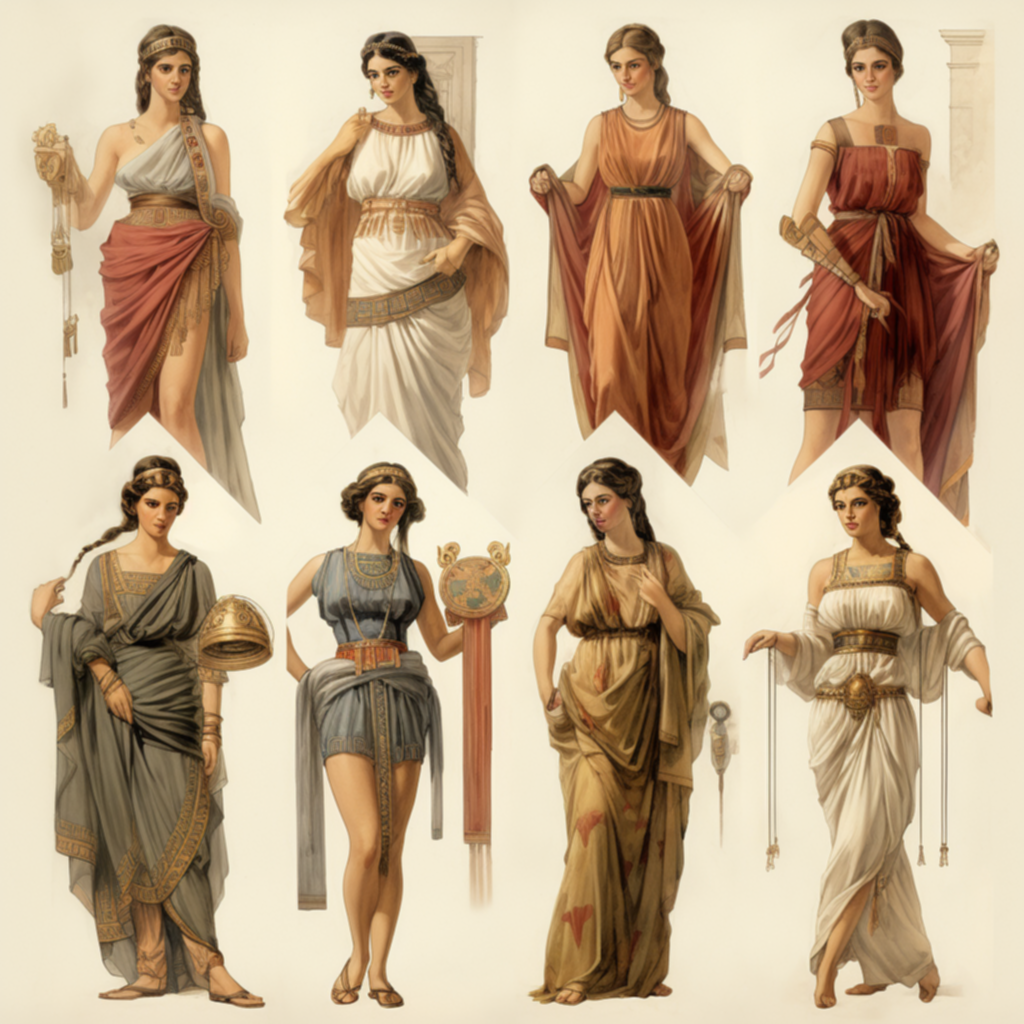
Ancient Roman Clothing
Ancient Rome, a civilization known for its military might, architectural marvels, and intricate political systems, also left a distinct mark on the fashion of antiquity. Roman clothing, like their architecture, demonstrated a balance between functionality and aesthetics. It also mirrored the social structures, societal norms, and cultural beliefs of the time.
4.1 Materials and Production
Roman clothing was primarily made of wool, produced locally in abundant quantities. Linen, imported from Egypt and Gaul, was also used, especially for summer clothing. In later periods, the Roman elite developed a fondness for silk, imported from the East, despite its exorbitant cost.
4.2 Basic Roman Garments
The basic garment for both men and women in ancient Rome was the tunic. Men's tunics were knee-length, while women's tunics, known as 'stola,' extended to the ankles. Over the tunic, men of citizen status wore a toga, a large semi-circular cloth draped over the shoulder and around the body. The toga was a symbol of Roman citizenship and was mandatory for official occasions.
4.3 Clothing and Social Status
In Rome, clothing was a direct reflection of one's social status. The color, decoration, and even the manner of wearing a toga indicated a person's social rank. The toga praetexta, with a purple border, was worn by senators and high-ranking magistrates. The toga picta, dyed entirely in purple and embroidered with gold, was reserved for triumphal generals and, later, for emperors.
4.4 Footwear and Accessories
Footwear varied depending on the occasion and status of the wearer. Sandals were common for indoor use, while various styles of boots were worn outdoors. Accessories played a significant role in Roman dress, with jewelry, like bracelets, necklaces, and rings, being widely worn by both sexes.
Ancient Chinese Clothing
The ancient Chinese civilization, known for its remarkable inventions, profound philosophies, and exquisite art forms, has also contributed significantly to the evolution of clothing. With a deep sense of aesthetics and symbolism, Chinese clothing traditions showcase a rich tapestry of cultural evolution spanning thousands of years.
5.1 Materials and Production
China is renowned as the birthplace of silk, and this luxurious fabric was the preferred choice for clothing, especially among the elite. Other materials such as hemp, ramie, and later cotton, were also used in garment making.
5.2 Basic Chinese Garments
The primary garment in ancient Chinese clothing was the Hanfu, a robe-like dress worn by both sexes. It was characterized by a cross-collar, a right-over-left wrap, a sash to secure the waist, and wide sleeves. The style, color, and material of the Hanfu varied based on the wearer's social status, the season, and occasion.
5.3 Clothing and Social Status
In ancient China, clothing was a significant indicator of social status and moral values. The elites, including the royalty and nobility, wore elaborately designed Hanfu made from fine silk, often embroidered with intricate patterns. Commoners, on the other hand, wore simpler Hanfu made from coarser materials.
5.4 Footwear and Accessories
Footwear in ancient China was crafted from various materials like cloth, silk, and leather. While cloth shoes were common among the masses, the elite often wore shoes made from finer materials. As for accessories, headwear held great significance, often denoting one's rank or title.
Chinese clothing traditions, with their strong emphasis on symbolism, aesthetic sophistication, and social stratification, provide a fascinating window into the cultural ethos of this ancient civilization. As our exploration continues, we will next delve into the vibrant sartorial tapestry of ancient India.
Ancient Indian Clothing
Ancient India, with its rich tapestry of culture, philosophy, and scientific insights, has left a deep impact on global civilization. Indian clothing, characterized by its diversity and vibrancy, reflects the subcontinent's multifaceted ethos and long history of textile production.
6.1 Materials and Production
The Indian subcontinent is home to a wide variety of natural fibers, including cotton, jute, and silk. Of these, cotton was the most widely used due to its comfort and adaptability to India's predominantly tropical climate. The art of weaving and dyeing was well-developed, contributing to the rich and varied textures of Indian garments.
6.2 Basic Indian Garments
The core elements of ancient Indian attire were the 'Dhoti' for men, 'Saree' for women, and 'Turban' worn by men as headgear. The Dhoti, a long unstitched cloth, is wrapped around the waist and legs, and its ends are knotted at the waist. The Saree is a long piece of cloth, ranging from five to nine yards, draped elegantly around the body.
6.3 Clothing and Social Status
Clothing was a reflection of social standing in ancient India, with the elite wearing finely woven cotton or silk garments, often dyed in vivid colors and adorned with gold or silver embroidery. The common people wore simpler, undyed cotton garments.
6.4 Footwear and Accessories
Footwear in ancient India ranged from simple sandals to elaborate, bejeweled ones worn by royalty. Accessories such as necklaces, bracelets, earrings, and rings made of gold, silver, and precious stones were popular among both sexes.
The clothing traditions of ancient India, with their emphasis on natural materials, vibrant colors, and intricate craftsmanship, provide a fascinating perspective on the country's historical and cultural landscape. As our journey draws to a close, we'll make our final stop in ancient Mesopotamia, often referred to as the cradle of civilization.
Ancient Mesopotamian Clothing
Ancient Mesopotamia, nestled between the Tigris and Euphrates rivers in present-day Iraq, is often hailed as the cradle of civilization. Known for the development of writing, law, and large-scale agriculture, Mesopotamia also had a distinct clothing culture shaped by its environmental conditions and societal structures.
7.1 Materials and Production
The primary materials used for clothing in ancient Mesopotamia were wool and flax. The region's dry climate was well-suited to sheep farming, making wool readily available. Flax was also grown locally, providing linen for the hotter months.
7.2 Basic Mesopotamian Garments
The typical garment worn by men and women was a type of wraparound skirt known as a 'kaunakes.' Initially, these were made from sheepskin, but later versions were made of tufted wool cloth to resemble sheep's wool. Over time, these garments became more elaborate, particularly for the upper classes.
7.3 Clothing and Social Status
Just like in many ancient societies, clothing was a reflection of social status in Mesopotamia. The wealthy often wore more complex and colorful kaunakes, decorated with intricate fringes and tufts. In contrast, the lower classes wore simpler versions.
7.4 Footwear and Accessories
Footwear was not commonly worn in Mesopotamia due to the warm climate. However, for protection against rough terrain or during the colder months, sandals or soft shoes made from leather or reeds were used. Jewelry was popular among both genders, with materials and designs signifying social status.
Ancient Mesopotamian clothing, influenced by the region's environmental conditions and societal structures, provides a unique lens into the world's first known civilization. This concludes our journey through the clothing of the ancient world, offering a glimpse into the lives, societies, and cultures of our ancestors.
Conclusion and Reflections
Our journey through the tapestry of ancient clothing has traversed various civilizations, each leaving an indelible mark on the evolution of clothing. From the simple tunics of Mesopotamia to the silk garments of China, from the togas of Rome to the draped attire of India, each civilization had its unique sartorial identity, invariably tied to its culture, environment, and societal structures.
The ancient Egyptians' linen garments reflected the necessity to stay cool in a hot, arid climate. The Greeks' draped chitons and himations mirrored their love for simplicity, form, and movement. The Roman togas, with their intricate wrapping, symbolized status in one of history's greatest empires. The silk Hanfu of China embodied the aesthetics and symbolism of an ancient culture. India's colorful dhotis and sarees showcased the subcontinent's love for vibrancy and variety. Lastly, the woolen kaunakes of Mesopotamia marked the beginnings of our sartorial journey.
Despite the differences in style, material, and form, the common thread running through these diverse clothing traditions is their role as an indicator of societal status and cultural identity. They were not just for covering and protecting the body but also served as a non-verbal medium of communication, signifying the wearer's social position, profession, and even personal characteristics.
This exploration underscores clothing as an integral component of human civilization, evolving hand-in-hand with societal changes, technological advancements, and cultural shifts. It's a testament to human ingenuity and adaptability, highlighting our intrinsic desire to express individuality and belonging through what we wear.
In retrospect, the panorama of ancient clothing unfolds as a fascinating narrative, speaking volumes about our ancestors' lives, values, and aesthetics. As we don contemporary attire, we carry forward this rich legacy, continually weaving the ancient threads into our modern fabric of dressing.
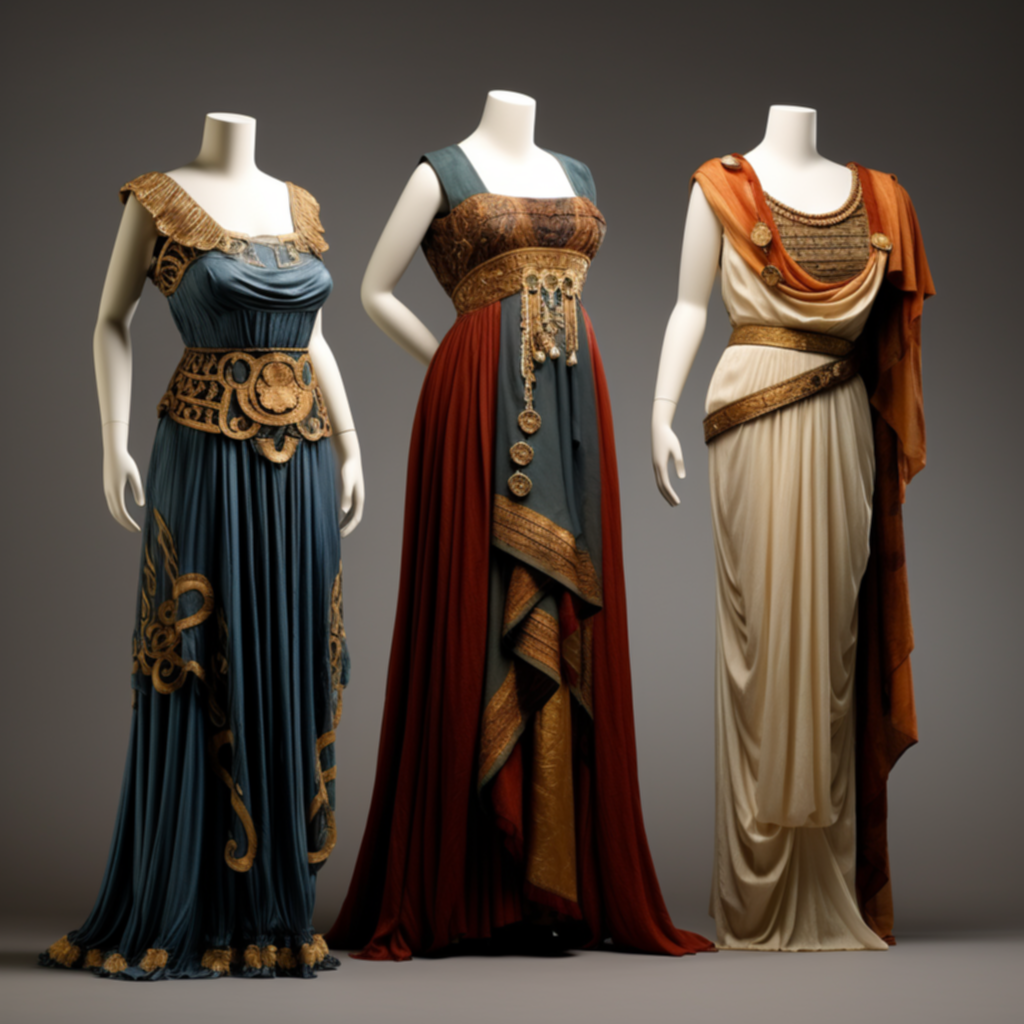
Frequently Asked Questions
1. What was the most common material used in ancient clothing?
The most common materials varied based on the civilization and available resources. Wool was extensively used in Greece, Rome, and Mesopotamia, while linen dominated in Egypt. In China and India, silk and cotton were preferred, respectively.
2. Did ancient societies have distinct clothing for men and women?
Yes, most societies had different attire for men and women, although there were common elements like the tunic in Rome or the Hanfu in China. These garments were often adapted differently by the genders.
3. How did climate influence ancient clothing?
Climate played a significant role in the materials used and the design of ancient clothing. For example, the Egyptians used light linen for their hot climate, while the Romans and Greeks used wool to suit their cooler, Mediterranean climate.
4. How was social status displayed through clothing in ancient times?
Ancient societies often used clothing as an indicator of social status. This was usually demonstrated through the quality of materials, complexity of design, color, and adornments. For instance, in Rome, the color and style of the toga indicated a person's rank.
5. What was the significance of jewelry in ancient clothing?
Jewelry in ancient clothing often served as markers of status, wealth, and in some cultures, protection against evil forces. They were commonly made of precious metals and gemstones, with designs that often carried symbolic meaning.





-500x500.jpg)
-500x500.jpg)
-500x500.jpg)
-500x500.jpg)
-500x500.jpg)